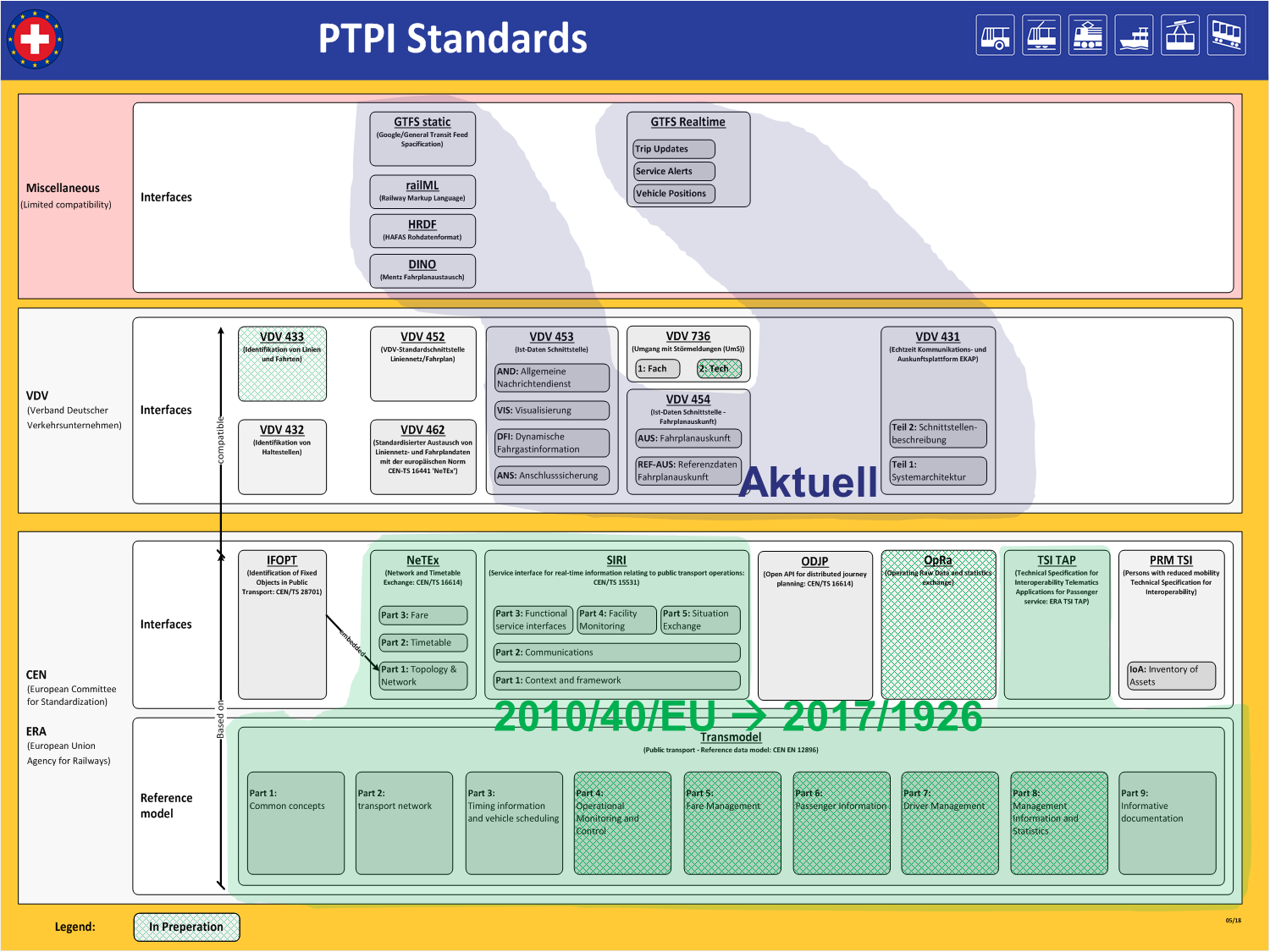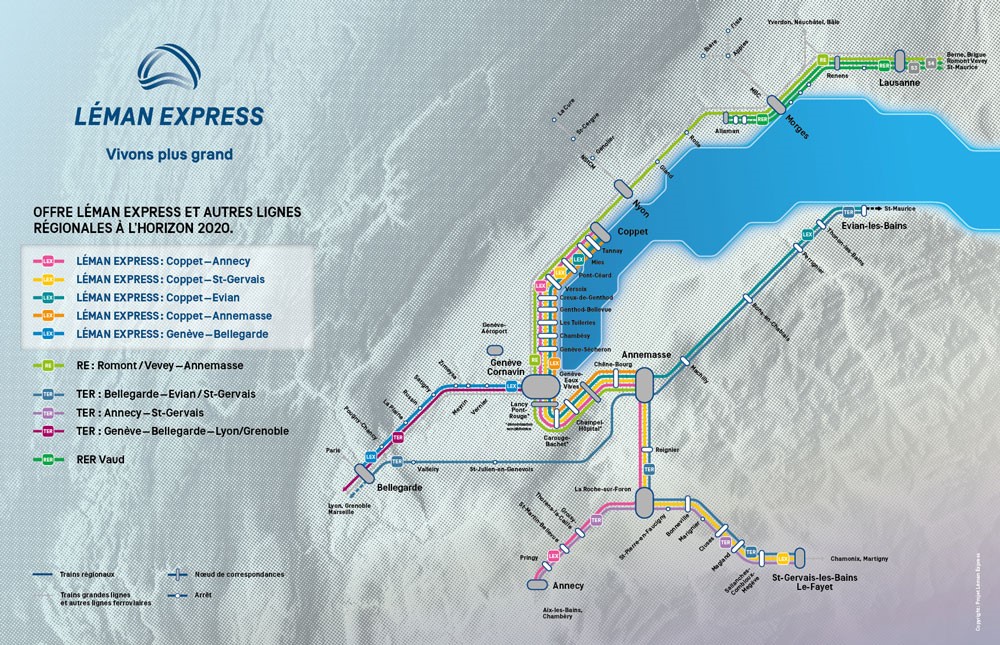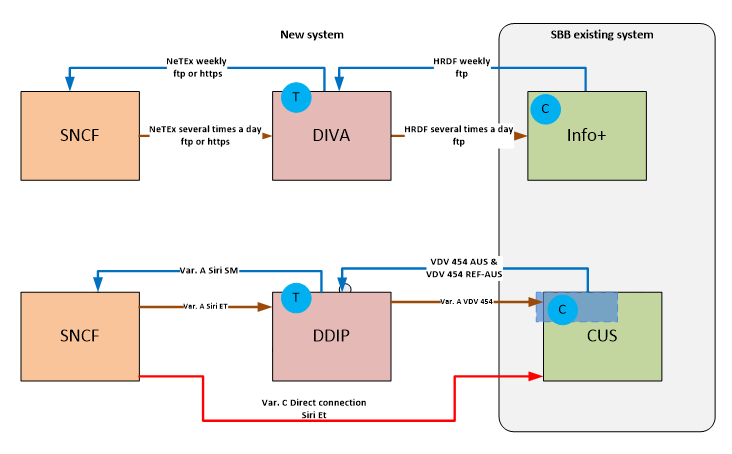
General information
The current standards for the exchange of Public Transport information are HRDF and VDV 453/454. For the public transport open data server VDV 431 was used (https://opentransportdata.swiss).
The introduction of IFOPT in Switzerland has already begun.
The SBB uses an internal architecture model (Famoos).
To integrate traffic in the Léman area (SBB and SNCF) we are now starting to use (Transmodel based) NeTEx and Siri standards. The project will be production ready by the end of 2019.
The current systems (Info+ for timetable and CUS for real-time PI aggregate the whole data on public transport in Switzerland in a single file and stream and provides it in different flavours to all data users. Data providers are obliged by law to provide the necessary information. SBB is tasked by the federal government in the form of SKI with aggregating and delivering the information. SBB is also tasked with improving the quality. In fact: There is already one national access point for the whole public transport system. There is no integration with air travel and some types of long-distance buses are not part of the system.
Fares are handled currently outside of this framework.
SBB is increasing its awareness of European standards. Currently the focus is in the blue shaded area. In addition, the green area will be considered more in future. Also, more focus on Transmodel as an architecture model is considered. As transforming in interfaces is easier, when the business architecture model is based on the same standard.
Note: VDV is also partially Transmodel based: e.g. VDV431 and CEN/TS 17118

For the project Léman Express PI (Passenger Information) will be exchanged with France. SBB will provide NeTEx timetables for the region (train and local transportation) and will obtain the relevant border belt from France (time tables for the three adjacent departments). For real-time exchange the subscription model will be used. SBB intends to import Siri ET for the border belt, SNCF intends to obtain Siri SM for selected points. Currently the definition of the border belt in Switzerland is:
- all cross-border traffic and lines
- all lines stopping at defined interesting stop places (in the case of France the railway stations of Léman Express, in Germany the stop places where SBB GmbH = SBB corporation train stops).
- All lines stopping at other defined points of interest (e.g. when with a 50 m walk over the border there may be an interchange.
Definition on the profiles to be used have started and experimental export of the data was done. The current implementation will act as a transformer HRDF <-> NeTEx and VDV <-> Siri (HRDF – Hafas Rohdatenformat = Hafas raw data format, https://opentransportdata.swiss/de/cookbook/hafas-rohdaten-format-hrdf/ , VDV https://www.vdv.de/ ). This will restrict the profiles for the time being. For real time currently two variants (A and C) are discussed.

Legend:
- T – Transformation
- C – Changes needed
- DIVA and DDIP are products by Mentz
- DIVA: Dialoggesteuertes Verkehrsmanagement- und Auskunftsystem = Time table planning system and collector
DIVA4 is web-based, multi-client capable that visualizes all planning contents on maps. DIVA4 meets the needs of smaller transport companies for quick, easy timetable scheduling and of large operators for complex planning and optimization tasks. DIVA4 is used by transport authorities and associations to exchange data and synchronized timetable data for any number of large networks. DIVA4 is thus able to serve as a database for high-quality, multimodal journey planning systems.
- DDIP: Dynamische Datenintegrationsplattform = Dynamic Data Integration Platform
The Dynamic Data Integration Platform (DDIP) is a central data platform for the reception, intermediate storage and transmission of real-time transport data from different data suppliers to diverse data recipients (subscribers). DDIP communicates with serving systems using standard real-time interfaces to exchange information. The common international standards supported are: VDV453 (ANS, REF-ANS, DFI, REF-DFI, VIS, AND), VDV454 (AUS, REF-AUS), SIRI (ET, PT, SM, ST, VM, CM, CT, SX and FM).
- Info+:
System for transformation of operational timetable data into data for passenger information, as well as a system for collecting, merging and providing timetable data originating from numerous sources (all Swiss transport organizations and from foreign countries).
- CUS:
The Customer Information System (CUS) is the centerpiece of the dynamic passenger information of the Swiss Rail (SBB). CUS is operated by SBB based on a direction of Swiss Federal Government and it is the real-time data platform for public transport Switzerland. The main advantage of CUS is the automation of providing passenger information for announcements or screens in railway stock. CUS includes around 20 single products like for example SMS alarm, mobile information tool for customer contact or VDV (Verband deutscher Verkehrsunternehmen) interfaces.
DiDok – Dienststellendokumentation = National Stop Database
DiDok contains all national stop points in Switzerland. Also, important foreign stop points are mapped within DiDok. Currently the most used part is an Excel implementation. For the time table currently HRDF contains all necessary stop point information. There may be differences between DiDok codes and Info+ codes for foreign stop points. The NeTEx implementation will contain the stop point information as well. DiDok will remain the master (and primarily accessible by an API – application interface – for internal usage).
Further Activites
SBB is considering further implementations
Target users
- Operators
- Data consumers (application providers)
- Open Data Users
Implementation scope
- All cross-border traffic and lines
- All lines stopping at defined interesting stop places (in the case of France the railway stations of Léman Express, in Germany the stop places where SBB GmbH = SBB corporation train stops).
- All lines stopping at other defined points of interest (e.g. when with a 50 m walk over the border there may be an interchange.
Functionalities
- Timetable data exchange with NeTEx and Siri between SNCF and SBB
- Realtime data exchange with NeTEx and Siri between SNCF and SBB
Usage
Permantent data exchange from 2019 onwards for timetables and realtime data.
